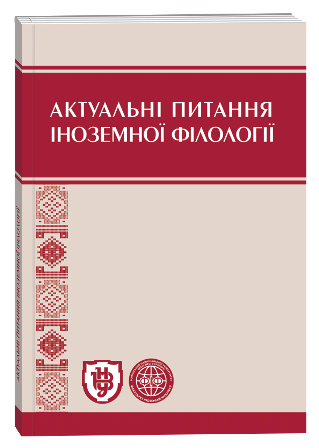MITTELHOCHDEUTSCH UND MODERNE OBERDEUTSCHE MUNDARTEN: PHONETISCH-PHONOLOGISCHER ASPEKT
DOI:
https://doi.org/10.32782/2410-0927-2025-22-13Ключові слова:
Mittelhochdeutsch, moderne oberdeutsche Mundarten, Phonetik, Phonologie, Walther von der Vogelweide, das NibelungenliedАнотація
Das Ziel der Arbeit ist es, die Eignung der modernen oberdeutschen Mundarten dazu zu prüfen, die phonologischphonetischen Eigenheiten und die Aussprachekonventionen der klassischmittelhochdeutschen Sprache zu rekonstruieren. Das Objekt unserer Forschung sind die modernen oberdeutschen Mundarten und das Literaturmittelhochdeutsche. Das Subjekt unserer Forschung ist der Phonembestand der modernen oberdeutschen Mundarten aus diachronischer Sicht. Zu den verwendeten Methoden gehören: Studium der Fachliteratur zur deutschen Dialektologie, Untersuchung der Phonetik des Mittelhochdeutschen anhand der dichterischen Texte Walthers von der Vogelweide und des Nibelungenliedes, Analyse der Lautlehre des Neuhochdeutschen. Die Aktualität der Arbeit ist dadurch erklärbar, dass die phonetisch-phonologische Struktur des Mittelhochdeutschen unlösbar bleibt, was durch Auseinandersetzungen und Zweifel bei der Darstellung der mhd. Aussprache nachweisbar ist. Wir stellen die Hypothese auf, dass zur Auflösung des Problems eine tiefere Studie im Bereich der Dialektologie beitragen dürfte. Zusammenfassung. Der Phonembestand der Sprache Walthers von der Vogelweide und des Nibelungenliedes widerspiegelt insgesamt die oberdeutschen phonematischen Merkmale, die die Folgeentwicklung des phonetisch-phonologischen Zustandes im Neuhochdeutschen bestimmen. Zur gleichen Zeit widersteht die mhd. Sprache bairischen dialektalen Veränderungen und weist die ahd. phonetisch-phonologischen Eigenheiten weiter auf. Dabei wird der Status quo durch die alemannische Mundart unterstützt, die sich konservativer als die anderen oberdeutschen Idiome ergibt. Die Zusammenstellung des klassischen Mittelhochdeutschen zu den oberdeutschen Mundarten bestätigt eine genetische Verbindung dazwischen, im Einzelnen mit dem alemannischen Idiom. Einerseits aber verwendet die klassische „Dichtersprache“ die alemannischen gedehnten Monophthonge <û>, <î> und <iu>, andererseits pflegt diese eine Verbindung zu den im Althochdeutschen etablierten ostfränkischen Konventionen und weist keine Lautverschiebung des [k] zu [kχ] auf.
Посилання
Березняк О. П. Німецька мова в Австрії: етапи формування і розвитку, тенденції в сучасному суспільстві. XIV Міжнародна науково-практична конференція «People and the world: global problems of human development». Philology. (December 18-20). Prague, 2023. С. 274-277.
Домброван Т. І. Діахронічна лінгвосинергетика: перші здобутки та вектори подальшого розвитку. Нова філологія. 2016. № 68. С. 154–160.
Christen H. Alemannisch in der Schweiz. Handbücher zur Sprach- und Kommunikationswissenschaft. Band. 30.4. Berlin/Boston: Walther de Gruyter GmbH. 2019. S. 246–278.
Das Nibelungenlied: Mittelhochdeutsch und übertragen von Karl Simrock. Berlin: Die Tempel-Klassiker, 1964. 641 S.
Eckhardt O. Alemannisch im Churer Rheintal. Von der lokalen Variante zum Regionaldialekt. Schweizerisches Idiotikon. Jahrebericht. 2017. S. 21-32.
Goerlich E. J. Ferdinand Sauter und die Wiener Dichtung. Leuvense Bijdragen. Tijdschrift foor Moderne Filologie. Nrs 1-2, Leuven, 1956/57. S. 85-95.
Hahn K. A. Gedichte des XII. und XIII. Jahrhunderts. Quedlinburg/ Leipzig: Gottfried Basse, 1840. 217 S.
Harnisch R. Ostfränkisch. Handbücher zur Sprach- und Kommunikationswissenschaft. Band. 30.4. Berlin/Boston: Walther de Gruyter GmbH. 2019. S. 363–406.
Hennig B. Kleines Mittelhochdeutsches Wörterbuch. Tübingen: Max Niemeyer Verlag, 2007. 499 S.
Köhler, R. Synergetik und sprachliche Dynamik [Synergetics and language Dynamics]. Natürlichkeit der Sprache und Kultur. Bochum: Brockmeyer, 1990. S. 96-112.
Lenz Alexandra N. Bairisch und Alemannisch in Österreich. Handbücher zur Sprach- und Kommunikationswissenschaft. Band. 30.4. Berlin/Boston: Walther de Gruyter GmbH, 2019. S. 318–362.
Lewizkij V., Heinz-Dieter Pohl. Geschichte der deutschen Sprache. Winnyzia: Nowa Knyha Verlag, 2010. 256 S.
Mettke H. Mittelhochdeutsche Grammatik. Max Tübingen: Niemeyer Verlag, 2000. 271 S.
Roelcke Th. Geschichte der deutschen Sprache. München: Verlag C. H. Beck, 2018. 128 S.
Schatz J. Die Tirolische Mundart. Ferd. Zeitschrift. III. Folge. 47. Heft. 1903. S. 1-94.
Schikola H. Schriftdeutsch und Wienerisch. Wien: Österr. Bundesverlag, 1954. 50 S.
Siebenhaar B. Dialekt und Hochsprache in der deutschsprachigen Schweiz. Zürich: Edition "Pro Helvetia", 1997. 57 S.
Walther von der Vogelweide. Gedichte (Mittelhochdeutsch / Neuhochdeutsch). Stuttgart: Philipp Reclam, 2012. 314 S.







